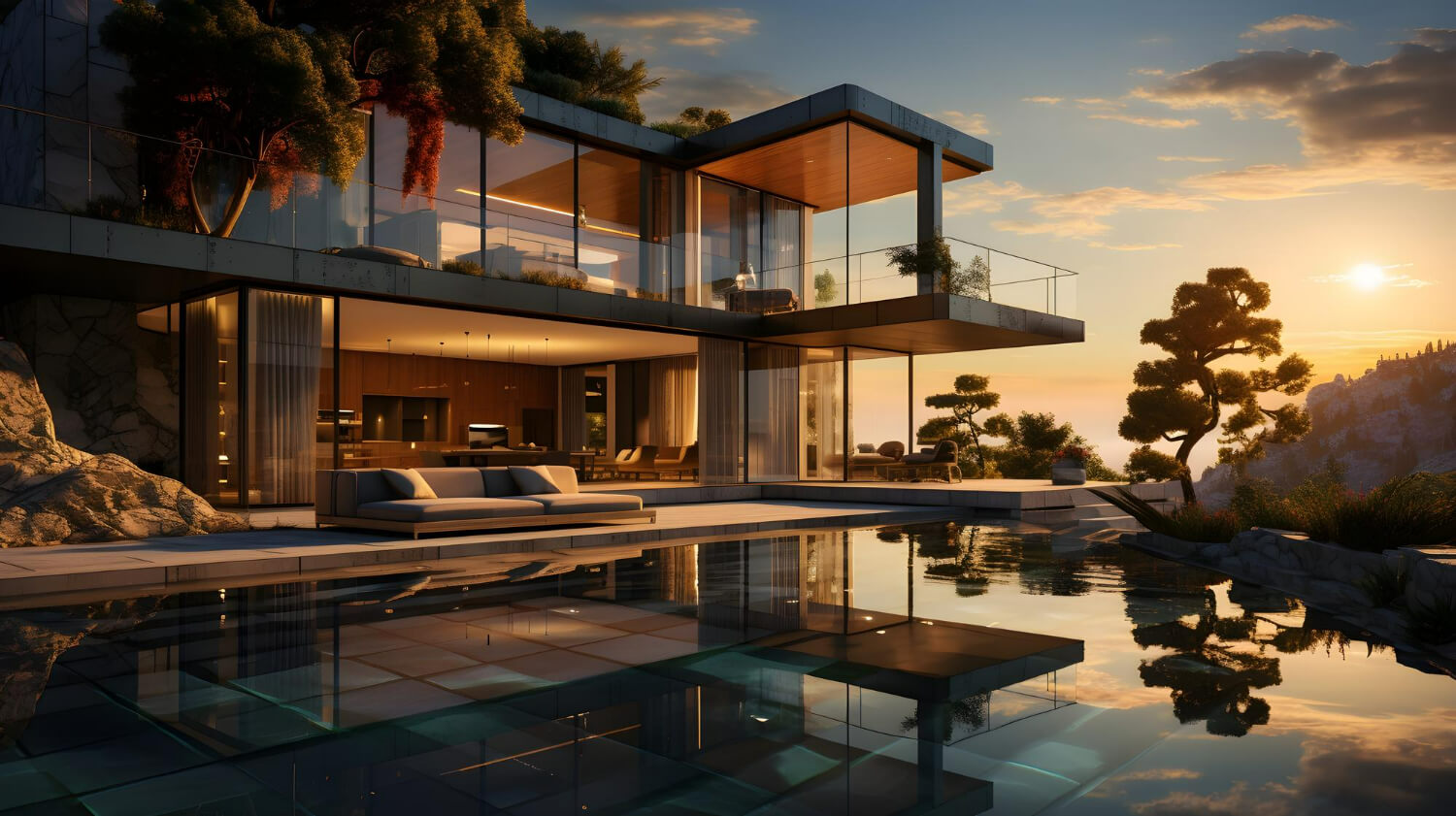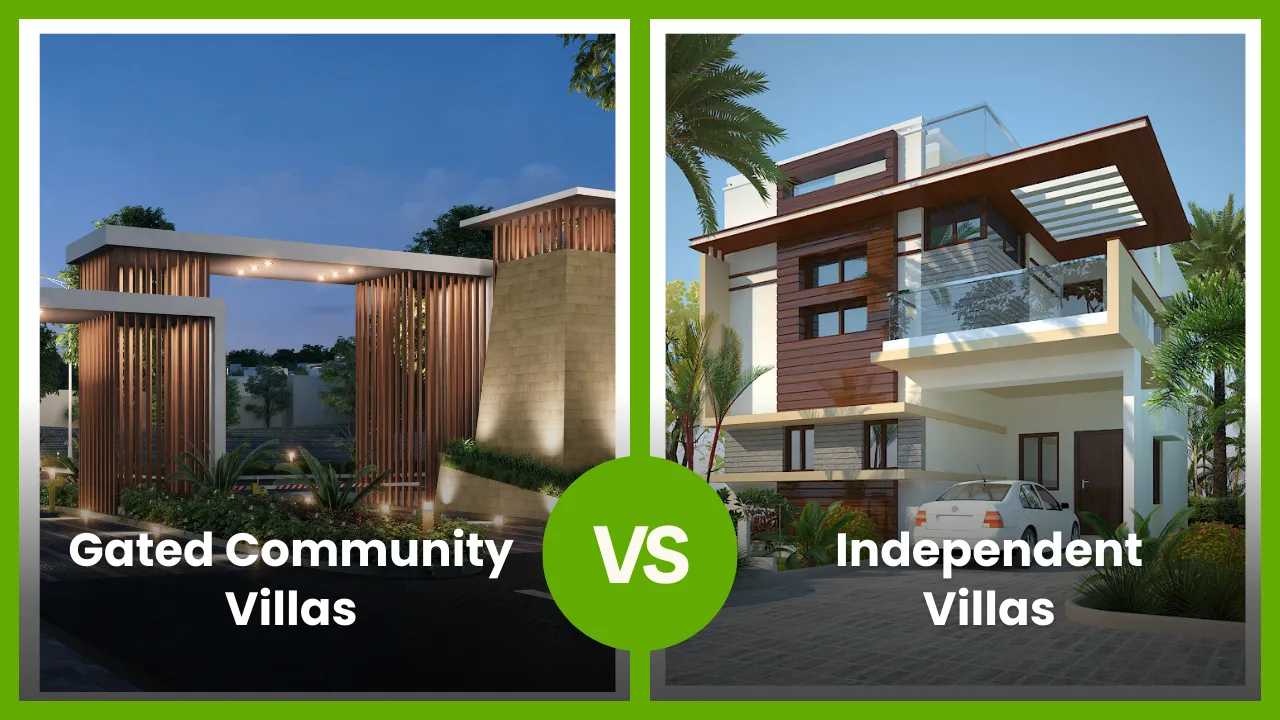Buying a home is one of the most significant investments you’ll make in your lifetime. Whether you’re a first-time homebuyer or looking to upgrade, understanding the differences between various types of homes is crucial. Today, we’ll explore the distinctions between two popular choices: villas and houses.
These differences might seem minor at first glance, but factors like budget, preference, and locality can significantly influence your decision. Let’s dive into the top 12 differences between villa vs house to help you make an informed choice.
Definition and Overview: Villa vs House
Understanding the basic definitions and characteristics of villas vs houses is essential. This section provides a concise overview, highlighting what sets these two types of homes apart. Whether you’re aiming for luxury or practicality, knowing the key differences can guide your decision-making process.
What is a Villa?
A villa is a luxurious, standalone residence known for its spaciousness, architectural grandeur, and opulent amenities. Originating from ancient Roman times as countryside estates for the elite, modern villas continue this tradition with modern design principles and high-end finishes. Villas are characterized by their exclusive locations and privacy, offering residents a retreat from urban life.
Common Features and Amenities Of Villas
- Luxurious swimming pools
- Landscaped gardens
- Private gyms
- Sports courts (tennis, basketball)
- Gated security
- Advanced home automation systems
- Spacious layouts and modern architecture
- Dedicated maintenance services
What is a House?
A house encompasses a broader category of residential buildings, ranging from compact bungalows to expansive multi-story homes. Unlike villas, houses are designed for practical living, accommodating diverse needs and preferences. Houses can be found in various locations, including urban centres, suburban neighbourhoods, and rural areas, catering to a wide range of budgets and lifestyles.
Common Features and Amenities Of House
- Private gardens or yards
- Garages or carports
- Basic security systems
- Traditional architectural designs
- Customizable interiors
- More varied in location and size
- Potential for adding personal amenities like a pool or gym
Top 12 Differences Between Villa and House

Let’s explore the top 12 differences Between Villa and House:
Locality and Environment: Villa vs House
Villas are typically situated in upscale, secluded areas that emphasize privacy and exclusivity. These locations are chosen for their natural beauty and tranquil surroundings, offering residents a peaceful retreat away from urban congestion. Villa communities often feature gated entrances, landscaped gardens, and private amenities such as pools and spas, creating a luxurious living environment.
Houses are more versatile in terms of location, spanning urban, suburban, and rural settings. The flexibility in house locations allows homeowners to choose environments that suit their lifestyle preferences, whether they prioritize convenience, community, or spacious surroundings. Houses in urban areas may offer proximity to amenities and cultural attractions, while suburban houses provide a quieter, family-friendly atmosphere.
Design and Architecture: Villa vs House
Villas are renowned for their modern and luxurious architectural designs, featuring expansive floor plans, high ceilings, and elegant finishes. The architecture of villas often incorporates contemporary elements such as glass facades, open layouts, and integrated smart home technology. The emphasis is on creating a visually striking and functional living space that reflects the owner’s taste and lifestyle.
Houses encompass a diverse range of architectural styles, from traditional to contemporary, reflecting regional preferences and historical influences. While some houses may adopt modern design principles, such as eco-friendly materials and energy-efficient features, others maintain classic aesthetics with brick facades and pitched roofs. House designs prioritize practicality and functionality, accommodating everyday living needs and family dynamics.
Amenities and Facilities: Villa vs House
One of the defining features of villas is their extensive range of amenities designed to enhance the resident’s quality of life. Luxury villas often include private swimming pools, home theatres, fitness centres, and landscaped gardens. These amenities create a resort-like experience within the confines of the property, catering to leisure, entertainment, and relaxation needs.
Houses offer a spectrum of amenities that vary depending on the property size, location, and owner’s preferences. Typical house amenities include kitchens equipped with modern appliances, outdoor spaces for gardening or recreation, and storage areas such as garages or sheds. Unlike villas, which prioritize luxury and leisure facilities, houses focus on providing essential comforts and practical living spaces.
Safety and Security: Villa vs House
Villas are known for their robust security measures, often located within gated communities or private estates. Security features may include perimeter fencing, surveillance cameras, and round-the-clock security patrols. The controlled access and enhanced security protocols ensure that villa residents feel safe and protected within their exclusive enclave.
Security measures for houses vary based on the property’s location and individual homeowner decisions. Some houses in secure neighbourhoods may benefit from community watch programs, alarm systems, and neighborhood patrols. However, houses in less secure areas may require additional security investments, such as installing security doors, motion-sensing lights, or home alarm systems.
Lifestyle and Living Experience: Villa vs House

Living in a villa offers a prestigious lifestyle characterized by privacy, luxury, and exclusivity. Villas provide ample space for indoor and outdoor activities, allowing residents to entertain guests, host events, and enjoy leisure pursuits without intrusion. The serene environment and personalized amenities create a sanctuary where residents can unwind and rejuvenate away from the pressures of urban life.
Houses foster a more community-oriented lifestyle that emphasizes family dynamics, social interaction, and neighbourhood engagement. Families living in houses often participate in local events, school activities, and community initiatives, fostering relationships with neighbours and creating a sense of belonging. Houses offer versatile living spaces that accommodate growing families, home offices, and recreational hobbies, promoting a balanced and fulfilling lifestyle.
Neighbours and Community: Villa vs House
Villa communities typically consist of residents from similar socioeconomic backgrounds, contributing to a homogeneous social environment. The exclusivity of villas ensures that residents share common values, lifestyles, and expectations regarding privacy and property maintenance. Villa neighbors often form close-knit communities, organizing social gatherings, and participating in shared activities within their private enclave.
Houses attract a diverse range of residents from various backgrounds, contributing to a vibrant and inclusive community atmosphere. Neighbourhoods with houses may include families, professionals, retirees, and individuals from different cultural and demographic backgrounds. House neighbours interact through neighbourhood associations, block parties, and community events, fostering a supportive and interconnected community network.
Social Status and Perception: Villa vs House
Owning a villa signifies high social status and affluence, reflecting the owner’s financial success and lifestyle preferences. Villas are associated with luxury, exclusivity, and prestige, positioning residents within an elite social stratum. The architectural grandeur, scenic locations, and premium amenities of villas contribute to their perception as symbols of wealth and achievement.
Houses convey a broader spectrum of social perceptions based on factors such as location, property size, and architectural style. While some houses in prestigious neighbourhoods may convey a sense of wealth and status, others in more modest areas may be viewed as affordable housing options for middle-class families. The perception of houses varies widely depending on the property’s condition, neighbourhood reputation, and community demographics.
Luxury and Comfort: Villa vs House
Villas epitomize luxury living with their expansive interiors, sophisticated finishes, and bespoke amenities. The architecture and design of villas prioritize elegance, comfort, and functionality, catering to the discerning tastes of affluent homeowners. Luxury villas may feature gourmet kitchens, spa-like bathrooms, private libraries, and entertainment lounges, creating a lavish retreat for residents to indulge in.
Houses prioritize practical comfort, providing functional living spaces that accommodate daily routines and family activities. Comfortable features of houses include spacious bedrooms, cozy living areas, and multipurpose rooms that adapt to changing needs. Houses may offer outdoor amenities such as gardens, patios, and play areas, enhancing the quality of life for residents seeking a comfortable and homely environment.
Investment Considerations: Villa vs House
Investing in a villa can be financially rewarding due to their high resale value and demand from affluent buyers. Villas in prime locations are often sought after for their luxury features, exclusivity, and potential for capital appreciation. Investors may benefit from rental income or long-term appreciation, making villas a lucrative asset in a competitive real estate market.
Houses offer diverse investment opportunities based on factors such as location, market trends, and property conditions. While houses may not command the same premium as villas, they can provide stable returns through rental income or property appreciation. Houses in desirable neighbourhoods or emerging markets may attract investors seeking affordable housing options with the potential for long-term growth.
Financing and Loans: Villa vs House
Securing a loan for a villa is often straightforward due to the high creditworthiness of villa buyers and the perceived value of luxury properties. Lenders may offer competitive interest rates, flexible terms, and personalized financing options tailored to the unique needs of villa purchases. Prospective villa buyers with strong credit histories and stable incomes may qualify for favorable loan terms, facilitating the purchase of their dream home.
Financing a house requires careful consideration of the property’s value, location, and borrower’s financial profile. While houses in established neighbourhoods may qualify for traditional mortgage loans with competitive rates, properties in rural or less affluent areas may require alternative financing options. Borrowers seeking to purchase a house may benefit from pre-approval processes, down payment assistance programs, and expert guidance to navigate the complexities of home financing.
Cost and Affordability: Villa vs House
Villas are renowned for their high purchase prices, reflecting the luxurious features, exclusive locations, and premium amenities offered to residents. The cost of villas varies based on factors such as property size, architectural design, and local real estate market conditions. In addition to initial purchase costs, villa owners may incur ongoing expenses for maintenance, security, and property management services, contributing to the overall cost of villa ownership.
Houses encompass a wide range of price points, making them accessible to diverse buyer demographics seeking affordable housing solutions. The cost of houses varies depending on factors such as property size, location, condition, and market demand. Affordable houses may appeal to first-time buyers, families, and investors seeking budget-friendly options with potential for long-term value appreciation. House ownership involves expenses such as property taxes, maintenance costs, and homeowners association fees, influencing the total cost of ownership over time.
Resale Value: Villa vs House
Villas are in high demand among affluent buyers seeking prestigious properties with luxury amenities and exclusive locations. The resale value of villas is influenced by factors such as market trends, property conditions, and location desirability. Owners of well-maintained villas in prime neighbourhoods may benefit from competitive resale prices and quick market transactions, maximizing their return on investment over time.
The resale value of houses varies based on factors such as local market conditions, property improvements, and buyer preferences. Houses in sought-after neighbourhoods with strong market demand may command higher resale prices and attract competitive offers from prospective buyers. Sellers of houses may enhance resale value through property upgrades, landscaping improvements, and strategic marketing efforts to appeal to potential buyers seeking affordable housing options with long-term investment potential.
Conclusion
We have covered a detailed guide on the Top 12 Differences Between Villa and House. The choice between villa vs house hinges on individual preferences, lifestyle priorities, and financial considerations. Villas offer unparalleled luxury, privacy, and social status, making them ideal for affluent individuals seeking prestigious residences with exclusive amenities. In contrast, houses provide practicality, community integration, and affordability, appealing to families, first-time buyers, and investors seeking versatile living spaces. Understanding the nuanced differences outlined in this guide empowers prospective buyers to make informed decisions aligned with their long-term goals and aspirations.
FAQs
Villas typically command higher purchase prices due to their luxury features, exclusive locations, and premium amenities. However, house prices can vary widely depending on factors such as property size, location, and market demand.
Converting a house into a villa would require extensive renovations, including architectural modifications, interior design upgrades, and installation of luxury amenities. The transformation would aim to create a luxurious and spacious living environment that meets the standards of a residence.
The suitability of a villa or a house for families depends on their lifestyle preferences, space requirements, and community expectations. Villas offer privacy, luxury amenities, and expansive living spaces, ideal for affluent families seeking exclusivity and comfort. Houses provide community integration, affordability, and practical living arrangements, appealing to families seeking a family-friendly environment with access to neighborhood amenities and educational facilities.
Yes, villas often have higher maintenance costs due to their larger size, luxury amenities, and exclusive features. Maintenance expenses for villas may include landscaping, pool maintenance, security systems, and property management services. Owners of villas should budget for ongoing maintenance to preserve the property’s value and ensure optimal living conditions.
Securing a loan for a villa is generally easier due to the perceived value of luxury properties and the creditworthiness of villa buyers. Lenders may offer competitive interest rates, flexible loan terms, and personalized financing options tailored to the unique needs of villa purchases. Prospective villa buyers with strong credit profiles and stable incomes may qualify for expedited loan approval processes, facilitating the purchase of their dream home.




